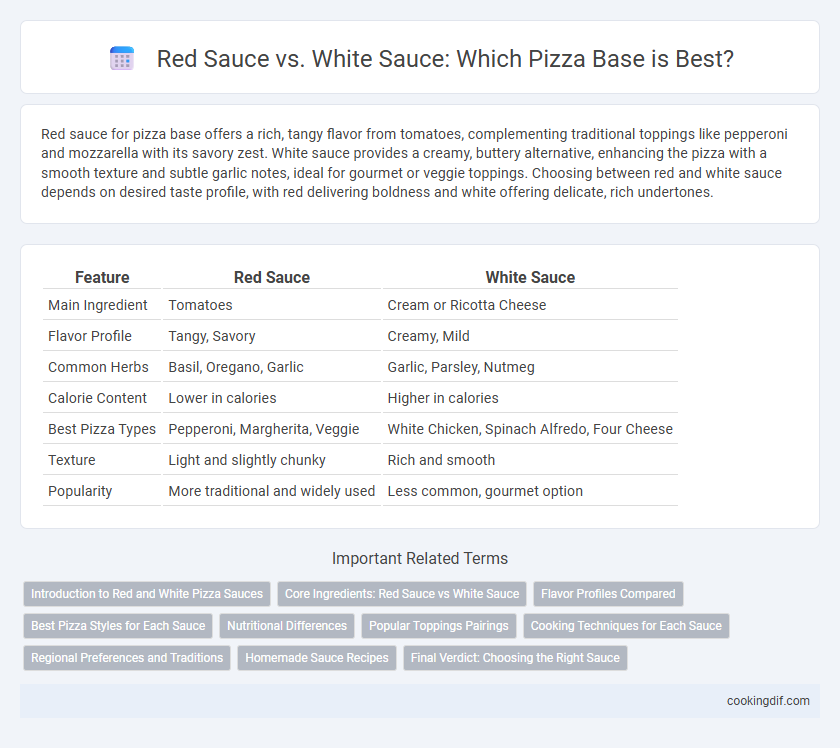Red sauce for pizza base offers a rich, tangy flavor from tomatoes, complementing traditional toppings like pepperoni and mozzarella with its savory zest. White sauce provides a creamy, buttery alternative, enhancing the pizza with a smooth texture and subtle garlic notes, ideal for gourmet or veggie toppings. Choosing between red and white sauce depends on desired taste profile, with red delivering boldness and white offering delicate, rich undertones.
Table of Comparison
| Feature | Red Sauce | White Sauce |
|---|---|---|
| Main Ingredient | Tomatoes | Cream or Ricotta Cheese |
| Flavor Profile | Tangy, Savory | Creamy, Mild |
| Common Herbs | Basil, Oregano, Garlic | Garlic, Parsley, Nutmeg |
| Calorie Content | Lower in calories | Higher in calories |
| Best Pizza Types | Pepperoni, Margherita, Veggie | White Chicken, Spinach Alfredo, Four Cheese |
| Texture | Light and slightly chunky | Rich and smooth |
| Popularity | More traditional and widely used | Less common, gourmet option |
Introduction to Red and White Pizza Sauces
Red sauce, traditionally made from tomatoes, garlic, olive oil, and herbs like basil and oregano, offers a rich, tangy flavor that complements classic pizza varieties such as Margherita and Pepperoni. White sauce, often based on bechamel or cream with garlic and parmesan, provides a creamy, smooth alternative ideal for gourmet pizzas featuring ingredients like chicken, mushrooms, and spinach. Both sauces serve as essential pizza bases, influencing the overall taste profile and enhancing the toppings' flavors.
Core Ingredients: Red Sauce vs White Sauce
Red sauce for pizza is traditionally made from crushed tomatoes, garlic, olive oil, and herbs like oregano and basil, providing a tangy and robust flavor profile rich in lycopene and antioxidants. White sauce, often based on butter, cream, garlic, and Parmesan cheese, offers a creamy, smooth texture with a rich, savory taste and a higher fat content that complements toppings like chicken and mushrooms. Choosing between red and white sauce depends on flavor preference and desired nutritional content, with red sauce being lower in calories and white sauce delivering a richer mouthfeel.
Flavor Profiles Compared
Red sauce for pizza delivers a tangy and robust flavor, enriched with tomatoes, garlic, and herbs like oregano and basil, creating a classic savory base. White sauce, typically made from cream or bechamel, offers a rich, creamy texture with subtle notes of garlic and cheese, providing a milder and smoother taste. The choice between red and white sauce significantly influences the pizza's overall flavor profile, with red sauce adding acidity and zest, while white sauce contributes a luxurious, velvety richness.
Best Pizza Styles for Each Sauce
Red sauce, rich with tomatoes and herbs, is essential to traditional styles like Neapolitan and New York-style pizza, providing a tangy base that complements mozzarella and pepperoni toppings. White sauce, made from creamy bechamel or garlic-infused oil, enhances gourmet pizzas such as Alfredo chicken or spinach and ricotta, offering a smooth, mild flavor ideal for delicate or vegetable toppings. Each sauce defines the pizza's character, with red sauce favoring robust, classic flavors while white sauce suits creamy, sophisticated combinations.
Nutritional Differences
Red sauce for pizza base is typically tomato-based, rich in vitamins A and C, antioxidants like lycopene, and low in calories, promoting heart health and immune support. White sauce, often made from cream or cheese, contains higher levels of saturated fat and calories, offering increased calcium and protein but potentially impacting cholesterol levels. Choosing between red or white sauce depends on individual nutritional goals, balancing nutrient density with calorie and fat intake.
Popular Toppings Pairings
Red sauce, made from rich tomatoes and herbs, perfectly complements classic toppings like pepperoni, mushrooms, and green peppers, enhancing savory and tangy flavors. White sauce, often a blend of cream, garlic, and cheese, pairs exceptionally well with chicken, spinach, and artichokes, offering a creamy and mild base that highlights delicate ingredients. Choosing between red and white sauce significantly influences the taste profile and texture of popular pizza topping combinations.
Cooking Techniques for Each Sauce
Red sauce for pizza base typically involves simmering crushed tomatoes with garlic, herbs, and olive oil to develop a rich, thick texture that balances acidity and sweetness. White sauce, often made from a roux of butter and flour combined with milk or cream, requires careful whisking and gentle simmering to achieve a smooth, creamy consistency that complements delicate toppings. Mastering the cooking temperature and timing for each sauce ensures optimal flavor release and prevents separation or bitterness during baking.
Regional Preferences and Traditions
Red sauce, made from tomatoes and herbs, dominates Italian-American pizza traditions, especially in regions like New York and Chicago, where its tangy flavor complements classic toppings. White sauce, often cream or ricotta-based, is preferred in parts of the Midwest and California, offering a richer, milder alternative that highlights fresh vegetables and seafood toppings. Regional preferences for red versus white sauce reflect local ingredient availability and cultural influences shaping distinctive pizza styles.
Homemade Sauce Recipes
Homemade pizza sauce recipes highlight the vibrant contrast between red and white bases, each offering unique flavors and textures. Red sauce, typically made from ripe tomatoes, garlic, olive oil, and herbs, delivers a tangy and rich foundation that complements classic toppings like mozzarella and pepperoni. White sauce, often crafted from a creamy blend of butter, garlic, cream, and Parmesan cheese, provides a smooth, indulgent alternative perfect for showcasing delicate toppings such as chicken or mushrooms.
Final Verdict: Choosing the Right Sauce
Red sauce offers a classic, tangy flavor rich in tomatoes and herbs, ideal for traditional pizza lovers seeking a vibrant base. White sauce provides a creamy, subtle alternative with garlic and cheese notes, perfect for those preferring a milder, indulgent taste. The final choice depends on personal preference and desired flavor profile, balancing boldness and creaminess to enhance the overall pizza experience.
Red sauce vs White sauce for pizza base Infographic

 cookingdif.com
cookingdif.com